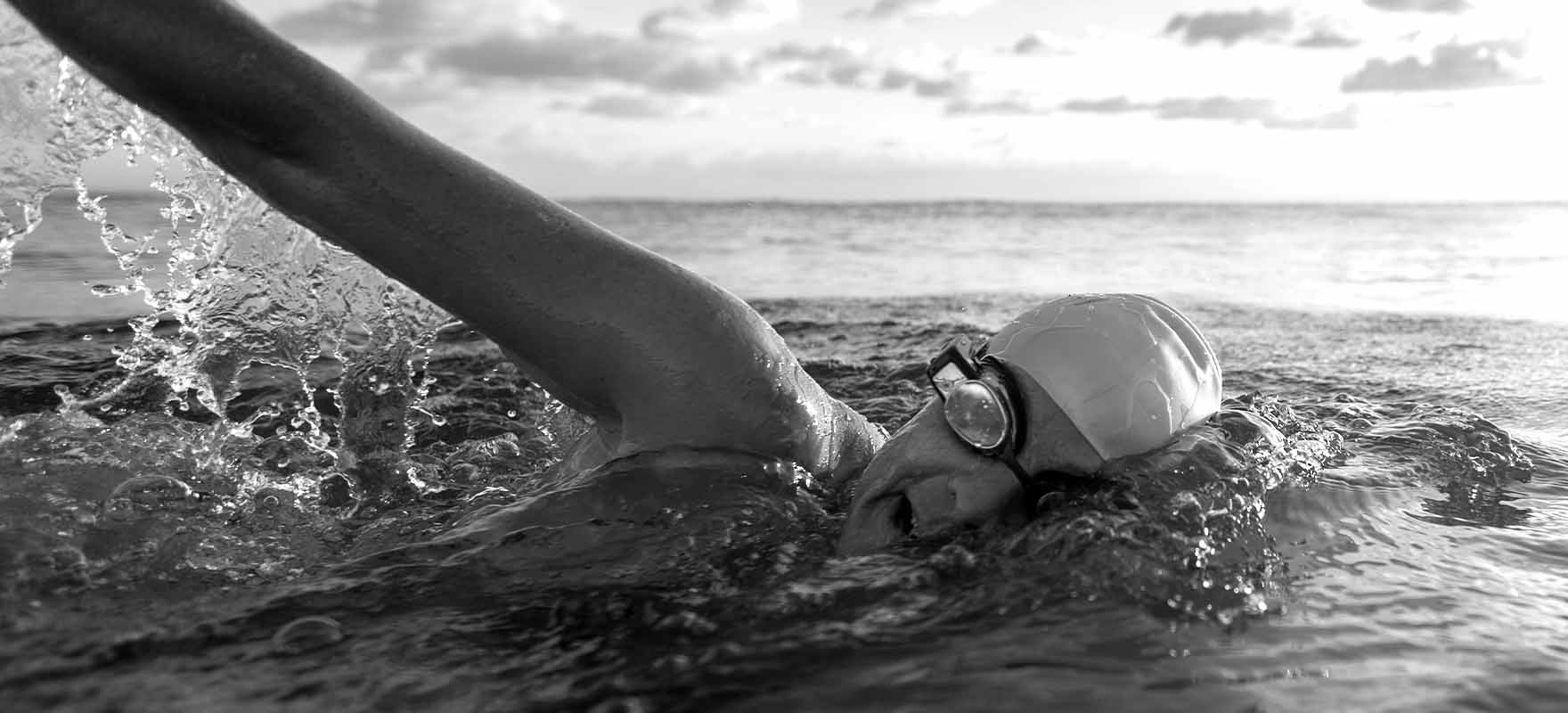The What, Why, and How of Open Water Swimming Training for Triathletes
No matter if you’re a first-timer or a seasoned triathlete, there’s just no substitution for open water swimming training.
While pool swimming can help you build your fitness and dial in your technique, the experience of swimming in open water can be jarring, even if you’ve done it many times before.
When your race finally arrives, your level of preparedness with open water swimming training will have a significant impact on your results for the day. But luckily, becoming a stronger open water swimmer is simply a matter of training your mind and body to feel comfortable in a challenging new environment.
Here’s what you need to know.
The Importance of Open Water Swimming Training for Triathletes
The majority of triathlons take place in a natural body of water, from oceans to lakes and reservoirs.
And racing with other athletes in open water is significantly different than training in a pool. That’s why even experienced triathletes still need to do open water swimming training before beginning their race season.
While open water swimming can be nerve-wracking at first, it just takes some getting used to. And once you become comfortable with it, you’ll supercharge your results—and enjoyment—on race day.
So, when you’re training for a sprint triathlon, getting prepared for an Olympic triathlon, or even making the jump to an Ironman-distance race, spending some time doing open water swimming training will help you feel calm and confident heading into the water.
The Biggest Challenges with Open Water Swimming Workouts
When it comes to open water swimming workouts for triathlons, going to the pool is incredibly important. But there are some elements of a real-world race that are tough to replicate in that environment.
Accessibility
Depending on your geographic location, open bodies of water simply aren’t as accessible to some triathletes as they are to others. It also requires unique equipment and, ideally, training partners to swim with.
It’s also often dependent on having the right weather and water conditions.
So, open water swimming is more challenging than heading to the pool, from a logistical perspective. That’s why many triathletes save these swims for the weekends when they’ve got a bit more time at their disposal.
Temperatures
In many places, water temperatures are one of the most startling differences between pool swimming and open water swimming training.
While a wetsuit can help keep you insulated, cold water is still a stark contrast from the warm waters of the pool.
But it’s not just an uncomfortable feeling: cold temperatures also have physical implications like causing your muscles to tense up and your breathing to become more erratic and shallow.
Even in areas where the water is warm, the variation in temperature between pools and open bodies of water is noticeable.
So, if you’re swimming in water temperatures above 20 degrees Celcius, it’s wise to learn to swim without a wetsuit to make sure you’re not training yourself to rely on your equipment.
Visibility
Unlike pools, many open bodies of water are murky, meaning your visibility is drastically reduced.
For one, this can have psychological implications since you can’t see the bottom, but it also makes it more challenging to discern which direction you’re swimming in.
Elements
While you might get a rogue splash here and there in a pool, open water swimming involves contending with the elements.
Wind can make it more challenging to swim, currents can take you off course, and choppy waters can mean waves are rolling onto your face from the front or sides.
And, of course, swimming in the heat from direct sunlight rather than the comfort of a covered pool can add another dimension of challenge.
Breaks
Taking a breather in open water is a different experience than it is in the pool. Since you won’t be able to stop and hang onto the edge, you’ll need to account for some additional energy expenditure to stay afloat or to swim back to shore for a break. Getting comfortable with treading water is also an important skill for when you need some rest.
Crowds
You typically won’t have to worry about big crowds of people around you during open water swimming training, but it’s something to keep in mind for race day.
Starting your race swim among a crowd of people and then navigating your way through other swimmers moving at various speeds makes it harder to be consistent and efficient in your pace, in turn depleting your energy reserves.
How to Stay Safe During Open Water Swimming Training
Given the added challenges it presents, it’s essential to take steps to stay safe during open water swimming.
Go With a Partner
Whenever possible, avoid swimming alone in open water. This is especially true if you’re new to it.
Bring a training buddy who can swim alongside you. Or consider asking a friend to come out with you in a small boat or on a paddleboard.
If you don’t have a partner to swim with, make sure you purchase a buddy buoy in case you need something to hang onto while you take a breather.
Be Visible
It’s important to make sure you’re visible to other people in the water, whether it’s boaters, jetskiers, or even other swimmers.
Your buddy buoy, which will generally be bright and fluorescent in color, will also ensure that you’re visible even in the water, even from a distance.
Check Water Quality
Checking the quality of the water you plan to swim in will help you avoid things like swimmer’s itch, infections, parasites, bacteria, and more. Municipalities or beach owner-operators regularly test many bodies of water and post results on designated local websites.
Riptides and Currents
Riptides and rip currents can pose a significant threat when you’re open water swimming training.
Rip currents are narrow currents of water, typically between 10 and 20 feet wide, that flow away form the shore. Riptides are more powerful currents that result from tide pulling water out from an inlet.
As a rule of thumb, if you get caught in either of them, stay calm and swim parallel to the shore until you’re able to make your way back in.
Know How Far You’ve Swam
Without lane lines and ropes or turns after each length, open water swimming training can be a disorienting experience.
So, it’s important to always keep track of how far you’ve swam and to make sure you’ve got enough energy to get back to the shore.
Your training watch will provide you with this information, although you’ll have to stop to determine how far you’ve gone. For a simple solution, you can have this data instantly accessible in real-time, displayed right in front of your eyes, by adding FORM goggles to your gear bag.
Rather than stopping and treading water to check your metrics, your goggles will tell you how far you’ve swam, how fast you’re going, and what your heart rate is at without you needing to pause your swim.
Essential Gear for Open Water Swimming Training
Open water swimming requires a lot less equipment than training in the pool, but there are a few key pieces of gear you’ll need and some important considerations to make with each.
Goggles
When you’re swimming in an indoor pool, you’re probably using clear-lensed goggles. But the best open water swimming goggles are slightly tinted and offer a degree of UV protection to keep your eyes safe from direct sunlight as well as light reflecting off the surface of the water.
FORM goggles have a slight tint to protect your eyes. But beyond that, seeing real time data can help keep you focused and distracted from the dark waters.
Buoy
We talked about the need for a buoy in the previous section, but this piece of equipment is important enough that it warranted mentioning again.
From a performance perspective, while it may add a small amount of drag to your swim, it’s not enough to be detrimental.
Wetsuit
Water that’s cooler than 24.6°C/76.28°F is considered wetsuit-legal for triathlons and it’s a wise idea to wear one. Not only will it help reduce the effects of cold water on your body, it also improves your buoyancy.
Open Water Swim Training Drills for Triathletes
The same way that you do drills in the pool when you’re training for a triathlon, working through drills during open water swimming training is a great way to improve and become more comfortable.
Breathing
Finding your breathing rhythm during open water swimming is a bit different than training in a pool, especially during the first 200 metres of your triathlon. When you begin your race, there will inevitably be high adrenaline levels, flailing arms, excessive splashing, and few opportunities to breathe. It can take some time to settle into your swim.
There are a few things you can do to improve your breathing in open water, including:
- Learning to breathe bilaterally in case you experience waves coming from one side
- Trying hypoxic breathing, which involves breathing on increasingly longer stroke intervals every for every 50 metres your swim, helps you get used to going further on fewer breaths
- Implementing a few simple techniques like looking to the sky, breathing in quickly, and lifting your head slightly to avoid waves
You can also practice skipping breaths for a few extra strokes to simulate what it will feel like if you’re forced to do so during the race.
Sighting
During your race, you won’t have lane lines and ropes to keep you on track. Instead, you’ll be following a set of buoys for the duration of your swim.
This is where sighting comes into play: regularly searching for landmarks during your swim to make sure you’re still heading in the right direction.
When you’re swimming in open water, try to focus on a specific and consistent point in the distance, such as a tree or a dock.
Every three strokes, as you come up to breathe, rotate your head forward and out of the water to get a quick glimpse of that landmark. Then, adjust your course accordingly.
Make sure to exhale when you’re sighting to avoid getting a mouthful of water.
Buoy Turn Drills
Navigating the buoys in a triathlon means having to make quick pivots while you’re on the move.
The rudder turn is a great way to get used to doing so.
This drill is simple: hold your inside arm straight ahead of you while using your outside arm as a rudder to steer you around the buoy.
For example, if you needed to make a right turn around a buoy during your race, you’d hold your right arm straight in front of you as you approached it, using your left arm as the rudder to swing you around it.
Repeat this drill a few times per side.
Pick-It-Up Drills
Since you’ll often be swimming in close proximity to athletes moving at varying speeds, it’s helpful being able to sprint for short distances to get past them or to slow down and let a faster swimmer pass before falling back into your pace.
You can work on your short-distance bursts of speed by taking 25 easy strokes and then 25 fast ones. You can also increase the volume of strokes of vary the number of each as you feel comfortable.
Start Drills
Unlike a pool, your race will most likely begin on a beach, treading water, or jumping off of a dock. And, rather than jumping into a pool and kicking off from the wall, you’ll be starting your swim by running into the water.
When you head out for your open water swimming training session, take a few practices entries into the water by running until you reach knee height then taking a dolphin dive followed by 30 seconds of hard swimming.
Repeat this drill as many times as you desire.
Things to Keep in Mind for Open Water Swimming
There are a few open water swimming considerations that will serve you well on race day.
Focus on Endurance
Given the challenges and variables that come with open water swimming, you’ll probably feel like you’re swimming less efficiently.
So, expect—and train for—a higher level of exertion than you’d expend in a pool for the same distance in open water.
It’s ideal to be able to swim twice the distance in a pool that you want to do during your open water swim.
You may want to consider working up to longer repeats—swimming longer distances without stopping—in the pool as a way to work up to longer swimming in the open water.
Prioritize Mental Preparation
Completing a triathlon is as much about mental strength as it is about physical fitness, especially during the swim.
That’s why training your mind to stay calm in the face of adversity is as important as training your body for fitness.
For example, you might miss a breath during your race because you get a splash of water on your face. So, understanding that it’s a possibility—and knowing how to handle it if it happens—can help you stay calm and keep moving forward.
The mental exertion that comes with swimming in open water, whether for training or during your race, is an element to be aware of and prepared for.
Try to Relax
This might feel easier said than done, but the more you can get relaxed in the water, the smoother and more efficient your swimming will be.
There’s no secret formula to it. Just like swim training in a pool, consistency is the key in open water as well.
The more you do it, the more comfortable you’ll feel.
Learn to Draft
Intuitively, your instincts on race day might tell you to find open spaces where you can swim at your own pace.
But you can actually do a form of drafting in the water by swimming within someone else’s slipstream.
This is a great way to let your foot off the gas a little bit and recover for a minute. It will also allow you to take a temporary pause from sighting.
Get More from Your Open Water Swim Training with FORM
For triathletes, open water swimming training brings a ton of additional challenges and considerations. And one of the best ways to become a better open water swimmer is to work through purposeful swim training in the pool.
That’s where FORM comes in. We help simplify the experience and help you make the most out of your pool training workouts so you can get stronger and more comfortable in open water.
With FORM, you'll swim with real-time metrics right there in your goggles. Plus, get a free 1-year membership and boost improvement in the pool with 1,000+ workouts, 30+ training plans, and a custom workout builder.
Backed by a 2-year warranty and 30-day return guarantee, FORM goggles are built to last.
Already have FORM goggles, but don’t have access to our full range of features? Head to the FORM app to start a 30-day free membership trial*.
*30-day free membership trial is only valid for one-time use for new members who have previously purchased FORM goggles.










